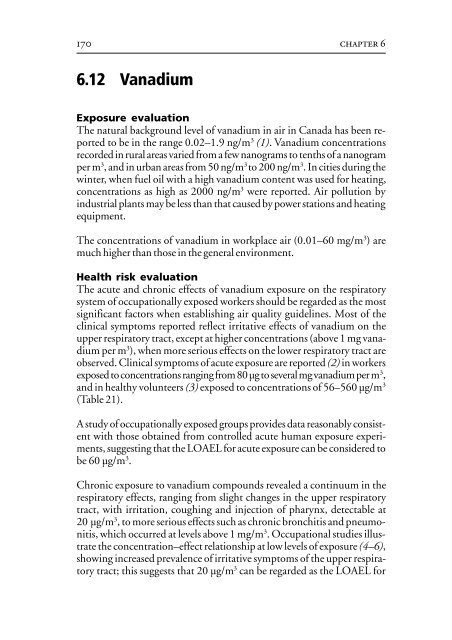Air Quality Guidelines - World Health Organization Regional Office ...
Air Quality Guidelines - World Health Organization Regional Office ...
Air Quality Guidelines - World Health Organization Regional Office ...
You also want an ePaper? Increase the reach of your titles
YUMPU automatically turns print PDFs into web optimized ePapers that Google loves.
170 chapter 6<br />
6.12 Vanadium<br />
Exposure evaluation<br />
The natural background level of vanadium in air in Canada has been reported<br />
to be in the range 0.02–1.9 ng/m 3 (1). Vanadium concentrations<br />
recorded in rural areas varied from a few nanograms to tenths of a nanogram<br />
per m 3 , and in urban areas from 50 ng/m 3 to 200 ng/m 3 . In cities during the<br />
winter, when fuel oil with a high vanadium content was used for heating,<br />
concentrations as high as 2000 ng/m 3 were reported. <strong>Air</strong> pollution by<br />
industrial plants may be less than that caused by power stations and heating<br />
equipment.<br />
The concentrations of vanadium in workplace air (0.01–60 mg/m 3 ) are<br />
much higher than those in the general environment.<br />
<strong>Health</strong> risk evaluation<br />
The acute and chronic effects of vanadium exposure on the respiratory<br />
system of occupationally exposed workers should be regarded as the most<br />
significant factors when establishing air quality guidelines. Most of the<br />
clinical symptoms reported reflect irritative effects of vanadium on the<br />
upper respiratory tract, except at higher concentrations (above 1 mg vanadium<br />
per m 3 ), when more serious effects on the lower respiratory tract are<br />
observed. Clinical symptoms of acute exposure are reported (2) in workers<br />
exposed to concentrations ranging from 80 µg to several mg vanadium per m 3 ,<br />
and in healthy volunteers (3) exposed to concentrations of 56–560 µg/m 3<br />
(Table 21).<br />
A study of occupationally exposed groups provides data reasonably consistent<br />
with those obtained from controlled acute human exposure experiments,<br />
suggesting that the LOAEL for acute exposure can be considered to<br />
be 60 µg/m 3 .<br />
Chronic exposure to vanadium compounds revealed a continuum in the<br />
respiratory effects, ranging from slight changes in the upper respiratory<br />
tract, with irritation, coughing and injection of pharynx, detectable at<br />
20 µg/m 3 , to more serious effects such as chronic bronchitis and pneumonitis,<br />
which occurred at levels above 1 mg/m 3 . Occupational studies illustrate<br />
the concentration–effect relationship at low levels of exposure (4–6),<br />
showing increased prevalence of irritative symptoms of the upper respiratory<br />
tract; this suggests that 20 µg/m 3 can be regarded as the LOAEL for

















